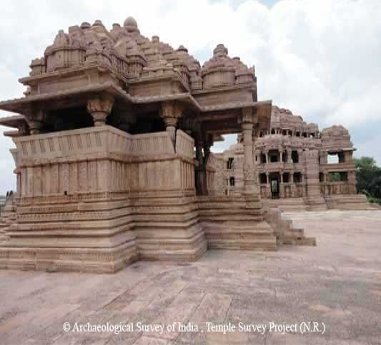Bhopal Circle
Protected Temples under Bhopal Circle, Archaeological Survey of India
Philosophically a Hindu temple is not merely a place of worship or a place of community gathering. Rather, we may call it abode of the supreme authority of the universe. In other words a temple is the house of God. According to ancient Indian Literature and Shilpa texts a Hindu temple is considered to be the human body of God. Thus various parts of a temple have been termed as pada, jangha, sikhara, mastaka, etc.
In general a Hindu temple is comprised of a square garbhagraha and a mandapa in front. An antarala connects the garbhagraha to the mandapa. In the beginning a temple was very simple in terms of its plan and elevation, having a square garbhagraha with a flat roof. Gradually, other parts like sabha-mandapa, mukha-mandapa, ardha-mandapa, high sikhara were added to it. The mandapa of a temple became highly ornamented and adorned with various decorative motifs on the pillars, pilasters, ceilings and architraves. Various projections were provided to high sikhara especially in North Indian temples.
The Hindu temples in India are broadly divided into the following three styles :

The basic component of northern temple is a square garbhagraha with pillared porch(mandapa) and a curvilinear sikhara above the sanctum .Sometimes, these temples are of panchayatana type in which the main temple is surrounded by four miniature shrines at four corners. The temple normally stands upon a high platform termed as jagati which can be approached through a flight of stepes from all three sides or one side.
The sikhara above the garbhagraha is high and often possesses a curvilinear shape. It bears three basic projections. The central one is known as bhadraratha, while the projections at the cardinal points are called karnaratha, and the projections in between these to is known as prathiratha. In the course of time the sikhara was provided with three, five, seven and nine projections. The most distinguished feature of the sikahra is the amalaka, fixed on the top, just below the crowning finial.
Contrary to the above South Indian temples have different features. Here, the temples are known as Vimana.The temples stand upon a square base with a high pyramidial tower obtained by superimposing diminishing stories. Haras (rows of miniature shrines) composed of Kutas and Salas are found at each of these storeys. The other unique feature of a South Indian temple is the gopuram or the temple gateway which is formet of various storeys over an oblong base. The storey on the ground floor has vertical walls, adorned with pilasters and niches. Two storeys are separated from each other by a horizontal moulding. Like the Vimana, it also has a pyramidal super structure adorned with Haras. It is crowned by a barrel vulted roof along with a row of stupis (finials). The prakara (enclosure wall) is another important feature of South Indian temples. The prakara is provided with a series of cells probably constructed for meditational purposes. The prakara encloses the main shrine as well as other structures inside. A bathing tank is also constructed near South Indian Temples which is necessary in the hot climate of the South.
Protected Temples under Bhopal Circle, Archaeological Survey of India
Protected Temples under the Jurisdiction of Kolkata Circle, Archaeological Survey of India
Protected Temples under the Jurisdiction of Raipur Circle, Archaeological Survey of India
Protected Temples Guwahati Circle, Archaeological Survey of India
Protected Temples under the Jurisdiction of Lucknow Circle, Archaeological Survey of India
Protected Temples under the Jurisdiction of Shimla Circle, Archaeological Survey of India
| Sr. | State | Circle | Protected by State/Central | |
|---|---|---|---|---|
| 1 | Madhya Pradesh | Bhopal Circle | Centrally Protected Temples | |
| 2 | Chhattisgarh | Raipur Circle | Centrally Protected Temples | State Protected Temples | |
| 3 | Uttar Pradesh | Lucknow Circle | Centrally Protected Temples | State Protected Temples | |
| 4 | West Bengal | Kolkata Circle | Centrally Protected Temples | |
| 5 | Assam | Guwahati Circle-North East | Centrally Protected Temples | State Protected Temples | |
| 6 | Arunachal Pradesh | Guwahati Circle-North East | Centrally Protected Temples | |
| 7 | Manipur | Guwahati Circle-North East | Centrally Protected Temples | State Protected Temples | |
| 8 | Tripura | Guwahati Circle-North East | Centrally Protected Temples | |
| 9 | Meghalaya | Guwahati Circle-North East | Centrally Protected Temples | |
| 10 | Himachal Pradesh | Shimla Circle | Centrally Protected Temples |